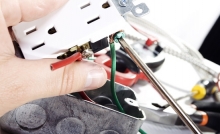
Interesting Facts About Famous Electricians
8 June 2015
Electrical engineering may refer to a specific area of engineering that is associated to the study of electricity, designing of circutory equipment, machine control, electromagnetism, electronics and power generation.
Electrical engineering became an area of great interest in the 17th century and it is basically the practical application of electricity which evolved and intensified during the 19th century. It is one of the most challenging yet exciting fields of engineering as it is rapidly growing and has proven to make significant impact on the modern society.
Alessandro Guiseppe Antonio Anastasio Volta
He was a pioneer in the field of electricity and the SI unit of electric potential was named after him as the Volt. He developed a concept of state of saturation of bodies in order to explain the attraction and repulsion of electrified bodies. He also invented the electrophore that was severely scrutinized and criticized by Beccara.
Andre Marie Ampere
The SI unit of electric current was named after him as the Ampere. Between 1820 and 1825 after a series of experiments, he provided factual evidence that affirmed that magnetism was indeed electricity in motion summarized in his famous 9 points that describe the law of action of carrying wires and model magnets as having circulating currents within them.
James Prescott Joule
The SI unit of energy was named after him as the Joule. He was the first to give an expression of the heat generated in a resistor by current flow and to also observe magnetostriction. He investigated the relationship between the internal energy of gas and temperature.
In 1860 he created one of the first most accurate galvanometers and calibrated it with the voltameter which ideally won him many awards.
Georg Simon Ohm
The Si unit of electrical resistance was named after him as the Ohm. After 1820 is when he bagan his electric and magnetic experiments. His first scientific paper sought a relationship between the length of wires and the decrease in force exerted by current carrying wires. In 1826 he published two important papers on galvanism electricity.
Charles William Siemens
He was a pioneeer in the practical application of scientific discoveries to industrial processes. The SI unit of electrical conductance was named after him as the Siemens (S). he developed a highly successful meter for measuring water consumption and also designed the cable ship 'Faraday' and assisted in the laying of the first several transatlantic cables.
Charles-Augustin Coulomb
The SI unit of quantity of electric charge was named after him as the Coulomb. In his electric studies, he determined the quantitative forcelaw, studied charge leakage and the surface distribution of charge on conducting bodies and gave the notion of electric mass.
Michael Faraday
The SI unit of capacitance was named after him as the Farad (F). he became the discoverer of electromagnetic induction, the fundamental relations between light and magnetism and the laws of electrolysis. He was the founder of the conceptions that underlie the modern magnetic field theory.
Heinrich Rudolf Hertz
It was he who first discovered, determined and measured electromagnetic waves in space and thus the SI unit for frequency was named after him as the Hertz (Hz).
News
10 February 2021
OTDS have completed manufacture of 4 shunt reactors and voltage...





.jpg)